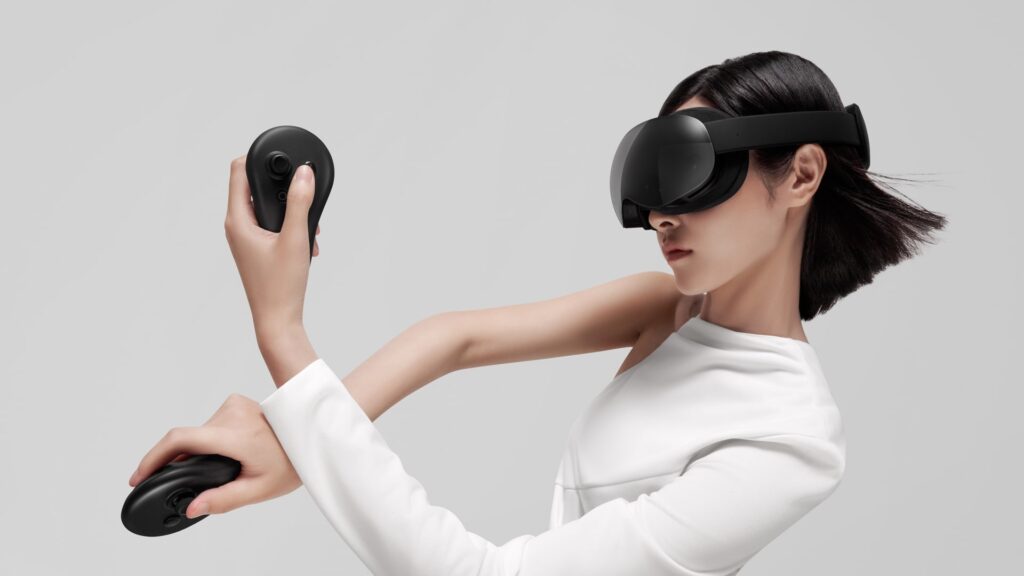Following Apple’s release of the Vision Pro, Chinese manufacturers are racing to catch up. Among those leading the charge is Chinese extended reality (XR) device manufacturer Play For Dream. On June 25, the company unveiled what it said is the world’s first Android-based spatial computer, “Play For Dream MR” (PFD MR), in Singapore. MR likely corresponds to the term mixed reality, representing the merge of physical and computer-generated or virtual experiences using technology.
Compared to its predecessors, Play For Dream’s latest offering boasts significant advancements in product definition, hardware specifications, software ecosystem, and spatial interaction. The PFD MR aims for top-tier configuration with a dual 8K micro-OLED screen and a self-developed resin pancake optics solution.
The optical display is the heart of any spatial computing device. The PFD MR’s dual 8K screens deliver an ultra-high resolution of 27 million pixels for binocular vision, with a central area boasting 45 pixels per degree (PPD). To blend the virtual with the real world, the device features 11 cameras, 7 types of sensors, and 22 infrared lights, reducing color VST latency to just 14 milliseconds.
The PFD MR is among the first spatial computers globally to be powered by Qualcomm’s second-generation Snapdragon XR2+ chip. The device has a thickness of only 33 millimeters and uses a 3:2 balanced weight distribution, significantly reducing pressure on the face and neck for more comfortable wear.
To further achieve natural interaction, Play For Dream has also developed tracking modules for head tracking (6 degrees of freedom, or DoF), controller tracking (6 DoF), gesture tracking (26 DoF), and eye tracking, equipping the device with the capability to sense human movements and operational intentions.
Innovation in interactivity is a major highlight of spatial computing devices. Previously, Apple’s Vision Pro introduced new paradigms of eye tracking and hand gestures. However, in practice, eye-hand interaction is not yet a perfect solution for scenarios requiring heavy feedback and high-precision interaction, and it also has a certain learning curve.
Therefore, besides supporting hand-eye interaction, the PFD MR retains the more familiar style of controller-based interaction while providing support for voice interaction.
In terms of application scenarios, the XR device primarily targets use cases related to spatial photography and cinematics as well as MR gaming.
As the first strategic partner of IMAX and DTS in the spatial computing and MR fields, Play For Dream is jointly exploring new spatial cinema standards. The PFD MR achieves IMAX-level cinema effects through its micro-OLED screen and DTS simulated 7.1 channel spatial sound effects.
The device offers various interactive gaming solutions, supporting precise hand-eye control while retaining the 6 DoF vibration controller for heavy feedback and high-precision scenarios, providing a more natural style of interaction.

Play For Dream’s CMO, Zhu Ran, said that the company has linked up with nearly 100 content providers and plans to expand these collaborations to overseas markets this year.
Currently, a major challenge for spatial computing devices is their isolated content ecosystems. Historically, the industry has tackled this by investing heavily in self-developed content or purchasing exclusive content collaborations. However, these methods are costly and unsustainable for startups. The industry is gradually finding new solutions.
Besides native MR and virtual reality (VR) applications, the company has put significant effort into optimizing the system to better integrate 2D content from computers and mobile games into spatial computing devices.
Cinema and gaming are undoubtedly the main focus for spatial computing devices, but spatial imaging is also an area of growing interest for developers. The PFD MR is equipped with dual 32-megapixel ultra-high definition 3D cameras, supporting spatial video and VR180 formats, with an ultra-wide recording field of view greater than 80 degrees.
According to 36Kr, numerous content applications based on spatial video have emerged both in China and internationally in recent years. Zhang Teng, who leads technology development at Play For Dream, said that spatial video represents the initial step in digitizing the real world. This innovation opens up new applications and promotes a sharing culture, potentially transforming into a vast market in the future.
Zhang also highlighted the development of a new “map module” that records the surrounding environment using point clouds, meshes, and semantic tags. The map module can quickly generate a map by sensing the environment through sensors.
Artificial intelligence is another key feature of the new product. The PFD MR is said to support AI-powered search, music creation, text translation, voice wake-up, voice control, and personal assistant functions. Additionally, the device features an AI-exclusive panoramic image completion function and there are plans to install support for 2D to 3D photo conversion and object recognition.
Zhang also told 36Kr that AI has already empowered many spatial computing modules, including simultaneous localization and mapping (SLAM), gestures, and eye tracking, integrating deeply into each module. He believes that generative AI will offer more functionalities in MR, including but not limited to 3D generative AI capabilities.
Besides the product launch, Play For Dream announced at the event that it will establish its Asia Pacific headquarters in Singapore, with the first overseas markets being Singapore and Malaysia, followed by Thailand, Indonesia, Vietnam, and Japan.
Zhu added that entering the Singapore market was a decision based on factors such as average monthly income and consumer habits. “Currently, the price range of our devices is relatively well-suited for Singapore,” Zhu said.
KrASIA Connection features translated and adapted content that was originally published by 36Kr. This article was written by Qiu Xiaofen for 36Kr.

